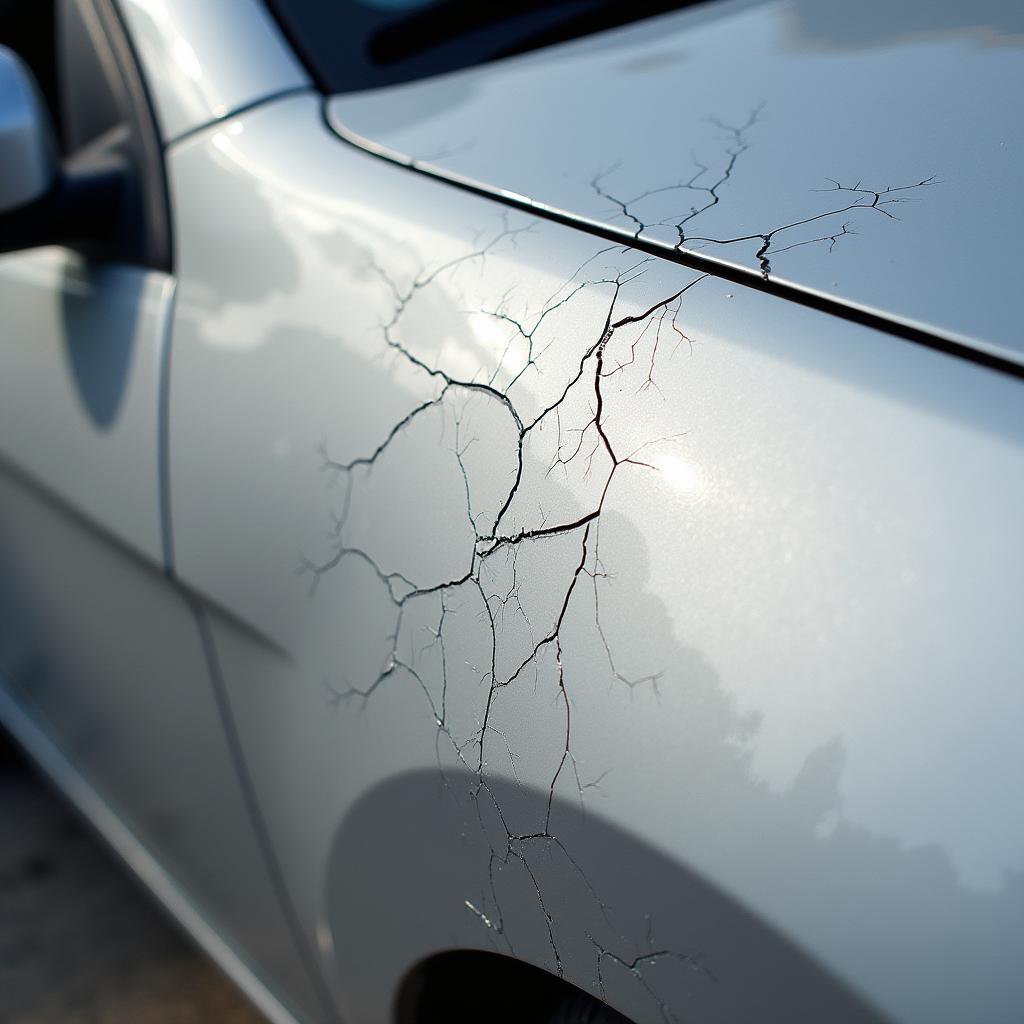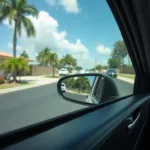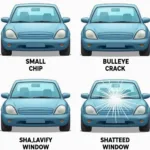Discovering a crack in your car’s paint can be disheartening, but fear not! It’s a common issue, and often, repairing it yourself is easier than you think. This guide will walk you through the steps to effectively repair those unsightly paint cracks and restore your car’s flawless finish.
Understanding the Enemy: Why Does Car Paint Crack?
Before diving into the repair process, it’s crucial to understand what causes those pesky cracks in the first place. Knowing the culprit can help you prevent future occurrences and ensure a long-lasting repair.
Here are the most common culprits:
- Sun Exposure: Prolonged exposure to the sun’s harmful UV rays is a leading cause of paint damage. The UV rays break down the paint’s chemical bonds, causing it to become brittle and crack.
- Weather Extremes: Extreme temperature fluctuations, from scorching heat to freezing cold, can stress the paint, leading to cracks over time.
- Improper Washing Techniques: Harsh chemicals, abrasive cleaning tools, and even using a dirty sponge can gradually wear down the paint’s protective layer, making it susceptible to cracking.
- Minor Accidents: Even minor bumps and scrapes can compromise the paint’s integrity, making it more prone to cracking.
Assessing the Damage: DIY or Professional Help?
Now that you know what causes paint cracks let’s determine the extent of the damage. This assessment will help you decide whether it’s a DIY project or if you need professional assistance.
- Hairline Cracks: These are thin, superficial cracks that only affect the top layer of paint. They’re usually repairable at home with the right tools and a little patience.
- Deep Cracks: If the cracks are deep enough to expose the metal underneath, it’s best to seek professional help. These cracks require more complex procedures to prevent rust and ensure a seamless repair.
DIY Repair for Hairline Cracks: A Step-by-Step Guide
For those minor cracks, roll up your sleeves and follow these simple steps:
- Clean the Area: Thoroughly wash the area around the crack with car wash soap and water. Ensure the surface is completely dry before proceeding.
- Sand the Crack: Using fine-grit sandpaper (around 2000-grit), gently sand the crack and its surrounding area. The goal is to smooth out the edges and create a better surface for the touch-up paint to adhere to.
- Clean Again: After sanding, clean the area again to remove any dust or debris.
- Apply Touch-Up Paint: Using a fine-tipped paintbrush or a touch-up pen, carefully apply thin coats of matching touch-up paint to the crack. Allow each coat to dry completely before applying the next.
- Level the Surface: Once the paint is dry, use fine-grit sandpaper to carefully level the repaired area with the surrounding paint.
- Apply Clear Coat: If the original paint had a clear coat, apply a thin layer of automotive clear coat over the repaired area. This will provide extra protection and enhance the shine.
- Buff and Polish: After the clear coat has cured, use a polishing compound and a soft cloth to buff the area to a brilliant shine.
Seeking Professional Help: When to Call in the Experts
While DIY repairs are suitable for minor cracks, certain situations warrant professional intervention. Here’s when you should consider taking your car to a reputable auto body shop:
- Deep Cracks or Chips: As mentioned earlier, deep cracks that expose the metal require specialized tools and techniques to prevent rust and ensure a long-lasting repair.
- Extensive Damage: If the cracking is widespread or covers a large area, it’s best to leave it to the professionals.
- Lack of Confidence: If you’re unsure about your DIY skills or uncomfortable tackling the repair yourself, don’t hesitate to seek professional help. A quality repair is worth the investment.
To learn more about repairing paint cracks in your car, you can find additional resources here.
Preventing Future Cracks: Keeping Your Car’s Paint Job Pristine
Prevention is always better than cure. Here are some tips to safeguard your car’s paint and prevent future cracks:
- Regular Washing: Wash your car regularly using a pH-neutral car wash soap and a soft sponge.
- Waxing: Apply a high-quality car wax every few months to provide an extra layer of protection against UV rays and environmental contaminants.
- Covered Parking: Whenever possible, park your car in a garage or under a carport to minimize sun exposure.
- Prompt Repairs: Address minor paint imperfections like scratches and chips promptly before they have a chance to develop into larger cracks.
By understanding the causes of car paint cracks, knowing how to assess the damage, and following the appropriate repair or prevention methods, you can keep your car looking its best for years to come.
If you are interested in the cost of repairing car paint cracks, especially on the bumper, you can find more information here.
FAQs: Your Burning Questions Answered
Q: Can I use nail polish to repair a car paint crack?
A: While tempting, using nail polish is not recommended. Nail polish isn’t formulated to withstand the harsh outdoor elements and will likely chip and fade quickly.
Q: How long does it take for touch-up paint to dry?
A: Drying times vary depending on the type of touch-up paint and environmental conditions. Generally, allow each coat to dry for at least 30 minutes before applying the next.
Q: Can I use rubbing compound instead of sandpaper to level the repaired area?
A: While rubbing compound can help smooth out minor imperfections, it’s not as effective as sandpaper in leveling the surface after applying touch-up paint.
For a more comprehensive guide on how to repair cracks in your car’s paint, check out this helpful resource: How to Repair Cracks in Car Paint.
Need Help? We’re Here for You!
Facing a car paint crisis? Don’t stress! Our team of expert technicians is just a message away. Contact us via WhatsApp at +1(641)206-8880 or email us at [email protected]. We provide 24/7 support to answer your questions and offer top-notch solutions for all your car repair needs.



